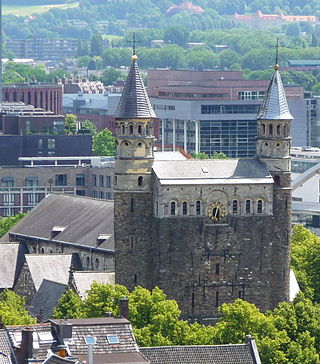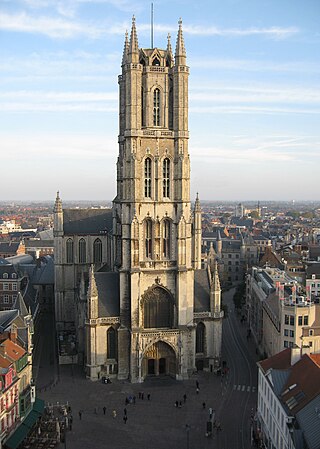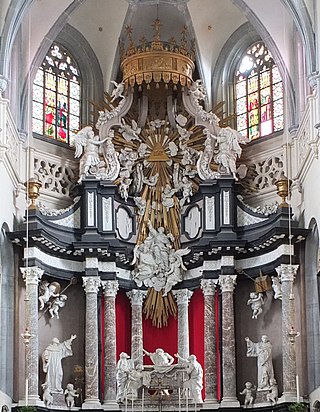
The Cathedral of St. Michael and St. Gudula, usually shortened to the Cathedral of St. Gudula or St. Gudula by locals, is a medieval Roman Catholic cathedral in central Brussels, Belgium. It is dedicated to Saint Michael and Saint Gudula, the patron saints of the City of Brussels, and is considered to be one of the finest examples of Brabantine Gothic architecture.

The Basilica of Saint Servatius is a Roman Catholic church dedicated to Saint Servatius, in the center of Maastricht, Netherlands. The architecturally hybrid but mainly Romanesque church is situated next to the Gothic Church of Saint John, backing onto the town's main square, Vrijthof.

Pieter Verbrugghen I was a Flemish sculptor from the Baroque.

Rombout Verhulst was a Flemish sculptor and draughtsman who spent most of his career in the Dutch Republic. An independent assistant of the Flemish sculptor Artus Quellinus the Elder in the sculptural decoration project for the new town hall in Amsterdam, he contributed to the spread of the Baroque style in Dutch sculpture. He became the leading sculptor of marble monuments, including funerary monuments, garden figures and portraits, in the Dutch Republic.
Erasmus Quellinus I or Erasmus Quellinus the Elder was a Flemish sculptor best known for classically inspired ornamentation work and copies after the antique. He was the founder of an important Antwerp dynasty of artists.

Saint Michael's Church is a Roman Catholic church in Ghent, Belgium built in a late Gothic style. It is known for its rich interior decoration.

The Basilica of Our Lady is a Romanesque church in the historic center of Maastricht, Netherlands. The church is dedicated to Our Lady of the Assumption and is a Roman Catholic parish church in the Diocese of Roermond. The church is often referred to as the Star of the Sea, after the church's main devotion, Our Lady, Star of the Sea.

Saint Bavo's Cathedral, also known as Sint-Baafs Cathedral, is a cathedral of the Catholic Church in Ghent, Belgium. The 89-meter-tall Gothic building is the seat of the Diocese of Ghent and is named for Saint Bavo of Ghent. It contains the well-known Ghent Altarpiece.

Hendrik Frans Verbrugghen or Hendrik Frans Verbruggen was a Flemish sculptor and draftsman, who is best known for his Baroque church furniture in various Belgian churches.

St. Andrew’s Church is a Catholic church in Antwerp built in the 16th century. Its exterior is mainly characterised by a late-Gothic style while its interior is predominantly executed in Baroque style. It is the parish church of the Parish of St. Andrew’s. During the nineteenth century the St. Andrew's Parish was known as the parish of misery as it was by then mainly populated by poor people.

The Church of Our Lady of Victories at the Sablon, or the Church of Our Lady of the Sablon, is a Roman Catholic church located in the Sablon/Zavel district, in the historic centre of Brussels, Belgium. It is dedicated to Our Lady of the Sablon.

St. Paul's Church is a Roman Catholic church located at the Veemarkt in Antwerp, Belgium. Its exterior is mainly Gothic with a Baroque tower while the interior is characterised by its rich Baroque decoration. It holds paintings by Antwerp's leading artists Peter Paul Rubens, Anthony van Dyck and Jacob Jordaens as well as abundant sculpture and church furniture crafted by leading Antwerp sculptors such as Artus Quellinus the Elder, Pieter Verbrugghen I, Jan Pieter van Baurscheit de Elder, Jan Claudius de Cock and Andries Colyns de Nole. Of particular note is the Calvary outside the Church which is made up of 63 life-size statues and nine reliefs executed in a popular and theatrical style.

The St. Walburga Church is a 17th-century Roman-Catholic church in Bruges built by the Jesuits in a Baroque style. It is now a parish church and contains many valuable art objects.

Artus Quellinus II or Artus Quellinus the Younger was a Flemish sculptor who played an important role in the evolution of Northern-European sculpture from High Baroque to Late Baroque.

Daniël van Vlierden was a Flemish sculptor who is mainly known for his Baroque sculpture in churches in the Prince-Bishopric of Liège. The style of van Vlierden is characterized by a sober realism in both the decorative elements as the figure sculptures.

The Collegiate Church of St. Peter and St. Guido is a Roman Catholic collegiate church located in the centre of Anderlecht, a municipality of Brussels, Belgium. It is dedicated to Saint Peter and Saint Guy, the patron saint of Anderlecht.

The Saint Quentin's Church or Sint-Kwintenskerk is a Roman Catholic church located at the Naamsestraat in Leuven, Belgium. Its exterior is mainly Gothic with a Baroque entrance portal. The interior contains Baroque choir stalls and altars. The church is named after the Saint Quentin, who is regarded in the Catholic faith as a protector against a wide range of contagious diseases.

Norbertus van den Eynde (I), Norbrecht van den Eynde and Norbert van den Eynde (also spelled: Norbertus van den Eynden, Norbert van den Eynden, and Norbertus van den Eynden) (Antwerp, baptized 11 December 1628 – Antwerp, 7 October 1704) was a Flemish sculptor. He is mainly known for his religious sculptures and church furniture. He was the son of the prominent sculptor Huibrecht van den Eynde and a member of the van den Eynde family of sculptors. Van den Eynde was a close associate of Artus Quellinus II. He undertook several commission in the Antwerp Cathedral, including several altarpieces.

Willem Ignatius Kerricx was a Flemish sculptor, painter, draftsman, architect, engineer, playwright and author active in Antwerp in the first half of the 18th century. His sculptural works comprise mostly sculptured church furniture, individual sculptures, mainly statues of saints for churches and a few funerary monuments. His sculptural style is typical for the late Flemish Baroque while he shows a preference for Classicism in his architectural projects. He took over the large family sculpture workshop in Antwerp. As a painter he created both history paintings for churches and still lifes. He was also employed as an architect and engineer, mainly on reconstruction projects. In his youth, he composed a number of comedies and tragedies for the Antwerp theatre.

Jan Frans Boeckstuyns, Boekstuijns or Boecxstuyns was a Flemish sculptor and architect who spent most of his active career in his native city Mechelen. He was also active as a manufacturer of gilded leather. While he mainly created church furniture and decorations, he also produced a number of small-scale works, including crucifixes and terracotta figures. He further designed architectural elements of buildings. His works show a transition from the high Baroque towards a more realistic and decorative style closer to the Rococo.





















